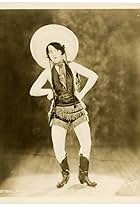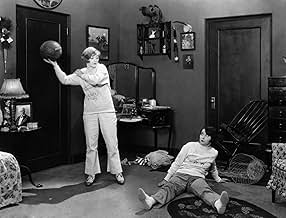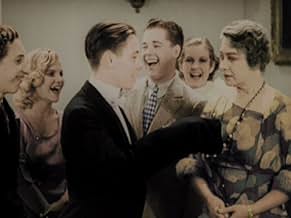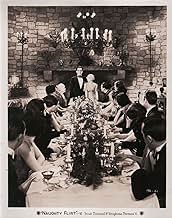Thelma Hill(1906-1938)
- Actress
Thelma Hill was born Thelma Floy Hillerman in Emporia, Kansas. Her family moved to Los Angeles, California during her
early teen years. Living just blocks from the Mack Sennett studio,
Thelma became one of the star struck, wide eyed girls who hung out near
the studio peering through the gates. It took her five years, but
eventually, using her womanly wiles, she weaseled her way through the
gates and quickly caught the eye of Sennett himself and F. Richard
"Dick" Jones, a producer and director who would work with Thelma in
over a dozen films.
Thelma did bit parts and extra work throughout her school years, working weekends and during vacations. Because of her youth, beauty, and spunk, she quickly became "everybody's protégé."
When Mack Sennett revived his famous "Bathing Girls," Thelma the first to don the suit, as most of her parts up till then had been in bathing suits. In her first movie, "Picking Peaches," she had dived off a pier.
Because of her "mah jongg" bathing suit, she became quickly known as the "Mah Jongg Bathing Girl," although she'd already carried around a nickname since her first days on the set: "Pee-Wee," the little black-eyed youngster who grew up on the old lot.
As she matured she was hired to double for Mabel Normand, who, because of a roaring cocaine habit often showed up late for work or not at all. It was about this time that Thelma became a flapper; a style of women who were known for their androgynous bodies, flimsy and revealing clothing, and the traditional male behaviors smoking, heavy drinking, and casual sex. It was the drinking that eventually led to Thelma's downfall. Near the end of her first year in film, 1924, her big break came when she got the lead opposite Ralph Graves in the two reel comedy "Love's Sweet Piffle" directed by Edgar Kennedy.
Thelma was the first Sennett bathing beauty, and one of the few, to make it into feature films. She starred opposite Ben Turpin in "The Prodigal Bridegroom," and got one of the two female leads in the hilarious Laurel & Hardy "Two Tars" in 1928.
When Hollywood brought Jimmy Murphy's comic strip "Toots and Casper" to life on the big screen, Thelma got top billing opposite Bud Duncan as Casper, with Cullen Johnson as Buttercup and George Gray as Casper's boss. The series ran from 1927 through 1929.
One biographer wrote that she starred opposite a solo Stan Laurel (in "Pie-Eyed") but calling 24 seconds on the screen as a starring role seems a stretch.
Everyone in Hollywood knew Thelma was a real trooper with a knack for comedy. She willingly dropped her good looks to don thick black-rimmed glasses and a wild hairdo and work on two reel comedies rather than full length dramatic films. No part was too small for her. Later, during talkies, she played a bit part of a patient in the waiting room in W. C. Fields' "The Dentist." Today, all copies have been so cut up and repaired that her short scene has been lost.
She left Mack Sennett for a short stint with the Film Booking Offices of America (FBO) (also known as FBO Pictures Corporation) in 1927, and afterwards was signed by MGM to play a role in "The Fair Coed." It was about this time that she got engaged to St. Elmo Boyce, her director on the "Toots and Casper" shorts and a former Sennett cinematographer. Boyce and Hill both had drinking problems, Boyce having DUI arrests on his record. The relationship and Boyce's career began to fizzle and Boyce committed suicide in 1930 by poisoning. He'd just finished work on Columbia Pictures' most expensive film to date, "Dirigible."
Thelma Hill did not make the transition to talkies well. Her drinking and depression were starting to take their toll. She began working free lance for a variety of studios. She had made over 20 films in 1929, but with the advent of talkies and the end of frenetic slapstick comedy, she would work on just seven films over the next five years.
Her first sound film was "The Golfers" with the Sennett studios. Her next role was in a musical called "Two Plus Fours" featuring Bing Crosby as one of the Rhythm Boys. She took a small role in Frank Capra's drama, "The Miracle Woman," starring Barbara Stanwyck, a few more small, uncredited parts, one short educational film starring a very, very young Shirley Temple, and ended her career in 1934 at "The Lot of Fun," Hal Roach Studios, in the movie "Mixed Nuts." Her role was small, but unforgettable as she becomes the target of a professor of entomology's Arabian Sand Fleas.
She married John Sinclair (I), W. C. Fields' stunt double and gag writer, and settled into the role of housewife less than ten minutes away from the original Mack Sennett studios.
Whether fueled by her depression or her husband's hanging around with W. C. Fields, famous for his drinking, Thelma drank away her health and youth and died before her thirty-second birthday in 1938.
Biographers mistakenly attribute her cause of death to acute alcohol poisoning (erroneously reported as a "stomach ailment" in her obituary), but records show she had spent the last month of her life at the Edward Merrill Sanitarium (mistakenly listed in Culver City; actually in Venice, CA). She had been diagnosed with chronic alcoholism in 1932 and with pellagra (a B-vitamin deficiency, specifically niacin, often found in alcoholics) in 1937. The effects of malnutrition caused by alcoholism affect all organs in the body, and her official cause of death following an autopsy was cerebral hemorrhage.
Her body was cremated and the ashes were interred at Forest Lawn Memorial Park.
Thelma did bit parts and extra work throughout her school years, working weekends and during vacations. Because of her youth, beauty, and spunk, she quickly became "everybody's protégé."
When Mack Sennett revived his famous "Bathing Girls," Thelma the first to don the suit, as most of her parts up till then had been in bathing suits. In her first movie, "Picking Peaches," she had dived off a pier.
Because of her "mah jongg" bathing suit, she became quickly known as the "Mah Jongg Bathing Girl," although she'd already carried around a nickname since her first days on the set: "Pee-Wee," the little black-eyed youngster who grew up on the old lot.
As she matured she was hired to double for Mabel Normand, who, because of a roaring cocaine habit often showed up late for work or not at all. It was about this time that Thelma became a flapper; a style of women who were known for their androgynous bodies, flimsy and revealing clothing, and the traditional male behaviors smoking, heavy drinking, and casual sex. It was the drinking that eventually led to Thelma's downfall. Near the end of her first year in film, 1924, her big break came when she got the lead opposite Ralph Graves in the two reel comedy "Love's Sweet Piffle" directed by Edgar Kennedy.
Thelma was the first Sennett bathing beauty, and one of the few, to make it into feature films. She starred opposite Ben Turpin in "The Prodigal Bridegroom," and got one of the two female leads in the hilarious Laurel & Hardy "Two Tars" in 1928.
When Hollywood brought Jimmy Murphy's comic strip "Toots and Casper" to life on the big screen, Thelma got top billing opposite Bud Duncan as Casper, with Cullen Johnson as Buttercup and George Gray as Casper's boss. The series ran from 1927 through 1929.
One biographer wrote that she starred opposite a solo Stan Laurel (in "Pie-Eyed") but calling 24 seconds on the screen as a starring role seems a stretch.
Everyone in Hollywood knew Thelma was a real trooper with a knack for comedy. She willingly dropped her good looks to don thick black-rimmed glasses and a wild hairdo and work on two reel comedies rather than full length dramatic films. No part was too small for her. Later, during talkies, she played a bit part of a patient in the waiting room in W. C. Fields' "The Dentist." Today, all copies have been so cut up and repaired that her short scene has been lost.
She left Mack Sennett for a short stint with the Film Booking Offices of America (FBO) (also known as FBO Pictures Corporation) in 1927, and afterwards was signed by MGM to play a role in "The Fair Coed." It was about this time that she got engaged to St. Elmo Boyce, her director on the "Toots and Casper" shorts and a former Sennett cinematographer. Boyce and Hill both had drinking problems, Boyce having DUI arrests on his record. The relationship and Boyce's career began to fizzle and Boyce committed suicide in 1930 by poisoning. He'd just finished work on Columbia Pictures' most expensive film to date, "Dirigible."
Thelma Hill did not make the transition to talkies well. Her drinking and depression were starting to take their toll. She began working free lance for a variety of studios. She had made over 20 films in 1929, but with the advent of talkies and the end of frenetic slapstick comedy, she would work on just seven films over the next five years.
Her first sound film was "The Golfers" with the Sennett studios. Her next role was in a musical called "Two Plus Fours" featuring Bing Crosby as one of the Rhythm Boys. She took a small role in Frank Capra's drama, "The Miracle Woman," starring Barbara Stanwyck, a few more small, uncredited parts, one short educational film starring a very, very young Shirley Temple, and ended her career in 1934 at "The Lot of Fun," Hal Roach Studios, in the movie "Mixed Nuts." Her role was small, but unforgettable as she becomes the target of a professor of entomology's Arabian Sand Fleas.
She married John Sinclair (I), W. C. Fields' stunt double and gag writer, and settled into the role of housewife less than ten minutes away from the original Mack Sennett studios.
Whether fueled by her depression or her husband's hanging around with W. C. Fields, famous for his drinking, Thelma drank away her health and youth and died before her thirty-second birthday in 1938.
Biographers mistakenly attribute her cause of death to acute alcohol poisoning (erroneously reported as a "stomach ailment" in her obituary), but records show she had spent the last month of her life at the Edward Merrill Sanitarium (mistakenly listed in Culver City; actually in Venice, CA). She had been diagnosed with chronic alcoholism in 1932 and with pellagra (a B-vitamin deficiency, specifically niacin, often found in alcoholics) in 1937. The effects of malnutrition caused by alcoholism affect all organs in the body, and her official cause of death following an autopsy was cerebral hemorrhage.
Her body was cremated and the ashes were interred at Forest Lawn Memorial Park.

























